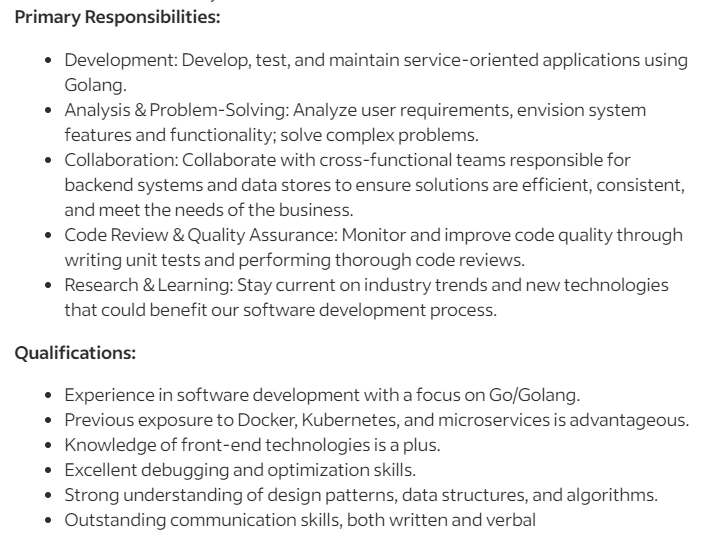The software development market is constantly evolving with new and new startups joining the race. To keep up with the fierce competition, business owners opt for technologies that allow developers to code fast while still preserving high product quality. And Golang can perfectly match the description. Developed by Google with an aim to eliminate the slowness and clumsiness of software development the company had at that time, today it’s a go-to for thousands of developers across the globe looking to build high-performing software products in various domains.
Finding the Perfect Fit: Select Go or Rust for Different Industries Wisely
Fast, simple, and efficient ‒ these words usually come to mind when talking of Go. With its straightforward learning curve and clear syntax structure, the language lets programmers write, as well as read, debug, and maintain, high-quality code fast instead of learning the language rules and principles for months.

Besides, such features as built-in concurrency support and a robust standard library allow coders to create software systems that comply with modern market trends, including cloud computing and microservices.
So it’s not surprising that Golang is adopted by many companies across the globe, such as Docker, New York Times, Dropbox, SoundCloud, and more. For instance, Twitch, a world-known live streaming platform, used Go because of its built-in support for concurrency which helps seamlessly handle millions of users’ requests simultaneously. Besides, its support for tooling, interfaces, and libraries made Go the right fit for CockroachDB, a distributed database system.
If you are also among Golang fans and want to launch a Go project, Bridge can help you out. As a global recruitment company with years of experience, we’ve prepared a Golang developer recruitment guide which includes popular hiring strategies as well as tips for finding the required talent. So, it’s time to dive into details.
The most popular strategies to hire Golang developers
As Golang is one of the most in-demand skills today, finding coders for your project might be a challenge. To help you cope with the task with flying colors and help you get the right talent fast, let’s have a look at popular hiring methods and consider their pros and cons.
Sourcing-as-a-service
Sourcing-as-a-service is an ideal option to free yourself (or your hiring team) from tedious recruitment tasks, but still be able to review candidates on your own. With Bridge, sourcing-as-a-service looks like this. Using our proprietary sourcing tool and tech-savvy recruiters, we narrow the pool of potential candidates, validate the information in their profiles, and provide you with a list of the most suitable applicants. The only thing left for you is to meet and greet the developers and decide on who to hire.
This hiring method allows you to speed up the process while searching for tech talent in various countries across the globe. What’s more, sourcing-as-a-service is cost-effective since you pay only a fixed monthly fee. The only drawback here is that it’s you who has to deal with training and candidate onboarding.
Let’s summarize the pros and cons of this hiring strategy.
| Pros | Cons |
| ✔️Get access to the global talent pool. | ➖Training and onboarding are on you. |
| ✔️Accelerate hiring with an automated sourcing engine. | |
| ✔️Get the first candidates within 5 business days. | |
| ✔️Save costs. |
But how do you know it’s a perfect fit for your business case? Here is a checklist to help you clear things up.
Choose sourcing-as-a-service if:
✅You can’t totally rely on third parties and want to be the final decision maker.
✅You need to find candidates fast.
✅You look for applicants you can potentially hire in the future.
✅You want to save resources and optimize expenses.
Hiring talent on your own
Another option is to handle the hiring process by yourself from start to finish. In this case, get prepared to write job descriptions, wait for CVs to come, filter them, create interview questions, vet candidates’ skills, conduct all types of interviews, and complete other tasks required to hire a good specialist. As you might have guessed, it won’t be quick. Plus, don’t forget about additional expenses ‒ they are also on your shoulders.
On the other hand, it’s a nice solution if you’re looking to be in full control of the hiring campaign. You can immediately change the strategy when needed, but it’s also you who has to deal with such challenges as tech talent shortage, and more.
Here are the advantages and disadvantages of hiring in-house:
| Pros | Cons |
| ✔️You have full control over the process. | ➖The process can stretch for months. |
| ✔️You personally select and communicate with each candidate. | ➖Competing for the best talent is not easy, especially without professional help. |
| ✔️You can change the strategy when necessary. | |
| ✔️You ensure potential candidates fit your company culture. |
To see if hiring in-house works in your specific case, look through the checklist below.
Choose in-house hiring on your own if:
✅You have plenty of time to completely delve into the hiring nuances.
✅You’re looking for a long-term engagement.
✅You have a technical background to test candidates’ skills.
✅You are not limited in financial resources to conduct a full-scale hiring campaign.
Hiring freelancers
Although having numerous alternatives, hiring freelancers remains a popular option in the tech hiring market. For instance, the number of registered freelancers in the USA in 2022 is around 60 million. Such platforms as Upwork and TopTal provide freelancers with gigs while helping companies find the required skills.
The most obvious benefits of this method are cost efficiency and flexibility. In other words, you get the required expert to complete a specific task (and no more than that) while saving costs on recruitment and a beneficial package. Talking of potential risks, it would be difficult to find a qualified coder if you are not a developer yourself. Also, freelancers work with no commitment so you can’t be 100% sure they complete the task within the deadlines.
To sum up, let’s consider the pros and cons of this solution:
| Pros | Cons |
| ✔️You can quickly find a coder for a short-term engagement. | ➖You don’t have any guarantees the task will be completed. |
| ✔️You pay only for the job done. | ➖You can hire a low-skilled engineer unless you have technical expertise. |
| ✔️You get access to the specialized skills your team currently lacks. | |
| ✔️You don’t have to train and onboard freelancers. |
To make sure hiring freelancers is a perfect fit for you, have a look at this checklist.
Hire freelancers if:
✅You need professionals to complete a small task.
✅You want to save costs.
✅You have solid expertise in hiring and cooperating with freelancers.
✅You need to test the waters before making full-time hires for a new project.
Outsourcing
Outsourcing is an age-old practice, where you get the work done by third-party contractors. Just like other hiring methods, it has its advantages and disadvantages that you shouldn’t ignore when looking for tech talent.
When talking about pros, it is a great solution when you want to be minimally involved in the development process or don’t want to be involved at all. Provided you partner with a reputable company, you get top-notch results without putting in too much effort. Besides, it’s an easy and fast way to assemble a full-fledged remote team including all other experts required, such as project managers, UX designers, and so on.
On the other hand, you have to pay for all benefits you enjoy. Apart from the direct costs according to the contract, get prepared for hidden fees and overheads that might suddenly appear in the middle of the project, like costs for software licenses, hardware, infrastructure setup, system configuration, and more. Anyway, let’s recap the advantages and disadvantages of outsourcing.
| Pros | Cons |
| ✔️You get a full-fledged development team. | ➖You can’t fully control the project. |
| ✔️You hire developers for a specific project. | ➖Hidden expenses. |
| ✔️Hiring abroad can significantly cut project costs. | |
| ✔️You can achieve project goals fast and hassle-free. |
Not sure if this hiring method meets your project objectives? Have a look at the checklist below.
Work with outsourcing vendors if:
✅You are a young startup that plans to build its first project.
✅You lack the expertise to control the software development project on your own.
✅You have a strict deadline and don’t have time to test all hiring options available.
✅You want to assemble a full-fledged team fast.
IT staffing services
If you are not looking for a dedicated team, but need only several experts instead, IT staffing services might be a nice option to fill your talent gap. However, it doesn’t mean with IT staffing you can hire a limited number of specialists. Bridge can help you find as many remote developers as you need, fast and effortlessly. So, how does IT staffing work?
Using our client-only platform, you create a job requisition and list requirements for programmers you plan to hire. Our recruiters search for suitable engineers and screen their skills to narrow the list of potential hires. Next, you interview the engineers. When the candidate is approved, we help you hire and onboard them. So overall, it’s as simple as ABC. The good thing here is that you are not involved in paperwork. Plus, hiring, team setup, and payroll operations are also on us.
Here is what you can get with IT staffing services:
| Pros | Cons |
| ✔️You get pre-vetted candidates with the required skill set. | ➖ You have to devote a decent amount of time to onboarding while still employing temporary staff. |
| ✔️ Transparent expenses without hidden costs and overheads. | ➖ Security concerns. |
| ✔️You can add experts to your team immediately when the workload increases. | |
| ✔️You save costs by paying only a developer’s rate, eliminating recruitment and hiring expenses. |
Now, let’s see whether IT staffing is your choice for hiring Golang developers.
Pick IT staffing if:
✅You need to add a niche expert to your project fast.
✅You look for a professional recruitment partner, but still want to control the process.
✅You are not ready to deal with overheads and hidden costs throughout the project.
✅You don’t have the time and resources to deal with paperwork and administration processes.
Being aware of the most popular hiring methods, you might still consider that you can successfully cope with the recruitment tasks on your own. So, here are some extra tips to help you get through the recruitment process with less stress.
How to hire a Golang developer on your own
Whether it’s your first time hiring programmers or you’ve done this before already, there’s a clear sequence of steps for you to walk through. The first one is to create a Golang developer job description, so let’s start with it.
Write a clear job description
Although Go is considered to be a programming language with a simple learning curve, it’s still better to find someone who has prior experience. Such an expert should understand Go syntax and paradigms, as well as be proficient in using its tools, frameworks, and libraries, including Echo, Beego, Gin, and more.
Depending on your project specifics, a Go programmer might be responsible for building a Golang application, developing back-end components, optimizing software performance, creating Go code documentation, and more. Even understanding the core principles of programming in Go, it might be difficult to test Golang developer skills and how an applicant interprets some basic things, like how to implement Goroutine. However, it’s not a problem at all with Bridge. We work with technical recruiters who can do the hardest job for you.
Here is a fragment of a Golang developer job description, to give you an idea of how it might look.

Prepare Golang developer interview questions
When you have filtered all the resumes and shortlisted candidates, it’s time to interview them. At this stage, make sure you have a list of questions that will help you assess the skills required for a Golang developer. These questions might be the following:
- What are the advantages of using Golang over other languages? Share some specific examples where you would use Golang.
- What are Golang pointers?
- How can you perform automated tests in Golang?
- What are packages in a Go program?
- What is a goroutine? How do you create and stop it?
Read our article to learn what other questions you can ask when interviewing software engineers.
Of course, you are not limited to these questions and can supplement the questionnaire with your own ones. But make sure you know the correct answers yourself before testing a candidate. At Bridge, we can help with it. Our tech-savvy recruiters ensure you get a Go coder proficient in the required tech stack.
Decide on the Golang developer salary
Last but not least, you should decide how much you are ready to pay a Golang developer. According to the Golang Cafe (Go job board), an average Golang developer salary is between $95,396 and $140,146 per year (before tax). Yet, it might differ depending on the programmer’s experience and location. For example, let’s compare salaries in Latin America:
| Country | Average Golang developer salary per month ($) |
| Brazil | ≈ $8300 |
| Mexico | ≈ $7900 |
| Argentina | ≈ $4150 |
And now, check out how much Go coders earn in Western Europe.
| Country | Average Golang developer salary per month ($) |
| Portugal | ≈ $17,100 |
| The UK | ≈ $16,600 |
| Spain | ≈ $16,250 |
| Finland | ≈ $14,150 |
If you want to learn more about salary ranges and market rates for Go developers, feel free to find them in our related article.
We can’t guarantee that you will get a top professional with no hassle, but it will definitely simplify and speed up the process for you. And if you want to get the burden of hiring campaigns off your shoulders, we can surely help you out.
Hire skilled Golang developers with Bridge
At Bridge, we understand the technology and rigorously screen candidates’ skills and work experience to provide you with an expert perfectly fitting your current project needs. With us, you may be 100% sure you fill the talent gap with the required skill set.
Partner with Bridge to find top Golang developers for your project!



